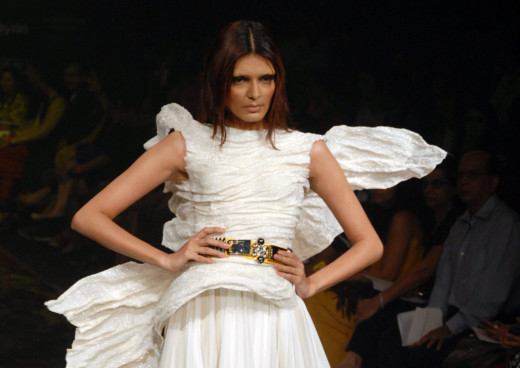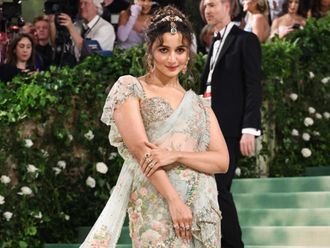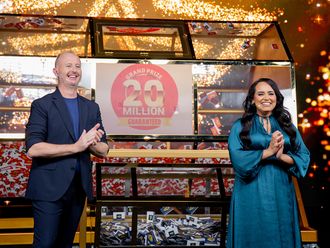
Shivan-Naresh and Swapnil Shinde
Designers Shivan and Naresh and Swapnil Shinde created quite a spectacle at their show on Monday with a laser lighting extravaganza which left the audience spellbound.
“The theme was speed. It is a very universal theme and we could easily adapt to it. It’s inspired from [the] anatomy of a horse,” Shivan and Naresh said after the show.
The garments included swimsuits, short dresses, loose tops and skirts. The major colours used were blue and grey.
Ace designer Shinde retained the laser lights, but darkened the colours to add to his theme of 1960s Bollywood horror. The woman in the white sari, with her pallu (the end of a sari) flying in the wind was what inspired him, he said.
“I was so inspired by the effect of wind on fabric that I decided to create it in my collection,” Shinde said.
The collection included gowns, button-down dresses and full-volume skirts. The gowns had fabric sticking out from the back — to depict the flying clothes, which was done to perfection.
The designer says he mostly stuck to “safe choices” in fabric like chiffon and georgette, but also experimented with organza. Black and white were used in abundance but there were a few looks in bright yellow and red as well.
Shinde said: “The inspiration was from black and white, dark greenish blue. But I think in a collection with dull colours, a shock of adding a bright colour makes a great impact.”
Sanchita Ajjampur
Designer Sanchita Ajjampur displayed a wide range of casual resort wear for men and women that was inspired by the Wild, Wild West.
Edgy and wearable were the keywords for her latest menswear offering. The collection included jackets, long shirts and casual T-shirts.
“The men’s collection was inspired by the native American Indian. It has a wide range of handcrafted resort wear. A man should not look like he spends too much time thinking about what to wear. The clothes need to be understated and subdued,” Ajjampur said.
The womenswear consisted of a lot of metallic black, gold and chiffons with magnificent embellishment.
Sanchita described the collection as the Fire Bird line.
“My collection is inspired by the legendary ballet called Fire Bird. It talks about the multiple aspects of a woman’s life,” the designer said.
The collection included a gorgeous range of cocktail dresses, gowns and miniskirts.
The designer said that though her collection has been made in India, it is “compatible with any place in the world”.
Bollywood celebrities Ira Dubey, Richa Chadha and Simon Singh were present at the show.
Shyamal-Bhumika
Designer duo Shyamal and Bhumika showcased their collection Maharaja, which started in style with two men dressed as royal guards escorting a model dressed as a princess, resplendent in a brown lehenga with heavy gold embroidery and a net dupatta.
“We wanted to recreate the grandeur of Indian royalty. Each garment took us 14 to 15 days to design and each is unique in its own way,” Bhumika said.
The line consisted of period outfits like full-length anarkali gowns, lehengas and saris for women and sherwanis for men made out of velvet in rich shades of champagne gold, deep green and ruby red with copper and gold embroidery and zardozi work.
Even though the 23 looks appeared heavy, the designers insisted they are comfortable to wear.
“We have kept today’s tradition in mind while designing the outfits and they are all wearable,” Bhumika said.
Abhishek Dutta
Fashion with a message — that was the idea behind designer Abhishek Dutta’s one-of-a-kind show. His models wore anti-pollution metallic masks during the show to support the cause.
“I wanted to promote the cause of anti-pollution through my collection and that is why all my models were wearing anti-pollution masks. The music also had honking sounds in it to portray heavy traffic,” the designer said.
The collection was based on the Chinese puzzle Tangram, which consists of seven triangular pieces put together to make different three-dimensional formations. Some of the garments in the shows were structured jackets, zipper jackets and jodhpurs for men and jumpsuits, maxi dresses and corset tops for women. Knitted kurtas were worn over jeans.
The look and feel of all garments was very edgy and grungy with the use of leather.
“Leather was the only thing which could support the strong look of the clothes. I understand that it is not right to use it, but I just want to clarify here that even though it is there is all the garments, it has been used minimally,” he said.
Bhairavi Jaikishan
Presenting elegant Indian cocktail wear for women, Jaikishan, known for using pastel shades and deep necked blouses, for the first time used deeper colours and high-necked blouses.
“It is not only traditional, it is young and stylised. I have used deeper colours like midnight blue, ivory, mustard, burgundy and black for the first time,” Jaikishan said.
The collection was an interesting mix of contemporary yet traditional Indian wear like lehengas, saris and the lehenga sari. For most of the saris, she used net and silver and gold work.
“The lehenga-sari is very interesting. It has the style of a lehenga with the grace of the traditional sari.”
The exquisite range of blouses had heavy work with embellishment on both the neck and the back.
“All my blouses have high embellished necklines which omits the need to wear any jewelled neck pieces with the outfit,” the designer added.










